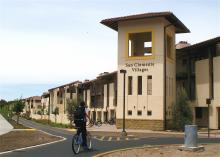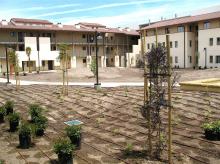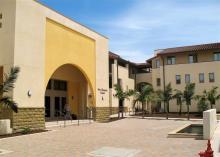
UCSB'S San Clemente Graduate Student Housing Project Receives Gold Certification From Green Building Council


UC Santa Barbara's San Clemente Villages graduate student housing complex has been awarded the Leadership in Energy and Environmental Design (LEED) gold-level certification by the U.S. Green Building Council (USGBC). LEED is the USGBC's rating system for designing and constructing the world's greenest, most energy efficient, and high-performing buildings.
The San Clemente project becomes the largest LEED-certified housing facility on any college or university campus in the country, according to officials with the USGBC. San Clemente Villages features four separate apartment buildings with 973 beds in 325 one-, two- and four-bedroom apartments. It is UCSB's first housing facility dedicated to single graduate students. The project also includes several community buildings –– providing meeting, study, and laundry space –– and a parking structure. Construction began in 2006 and was completed in fall 2008.
"This LEED Gold certification for San Clemente Villages is a wonderful testament to UC Santa Barbara's commitment to sustainable design," said Chancellor Henry T. Yang. "Our goal was to create a housing facility for our graduate students that would be affordable, appealing, and environmentally sensitive, and would promote the values of our campus and community. Thanks to the contributions of our faculty, staff, and students, our campus has become a ‘living laboratory' for the research, teaching, and practice of environmental sustainability."
Marc Fisher, senior associate vice chancellor, facilities management, said of the LEED certification: "I am very pleased that the USGBC has acknowledged and confirmed all of our efforts to create a sustainable, architecturally appropriate, affordable student housing complex for UC Santa Barbara with the designation of LEED Gold."
Ron Cortez, associate vice chancellor, administrative services, said that the certification marks another milestone in the university's sustainability efforts.
"The LEED certification of the San Clemente graduate student apartments serves as an icon of the university's longstanding commitment to the environment, as well as our potential to impact the future," Cortez said. "I am amazed at the cooperation among the faculty, staff, and students toward achieving the common goal of sustainability. This project truly demonstrates this synergy between all members of our campus."
According to Fisher, San Clemente Villages was designed to reflect the Mediterranean tradition of Santa Barbara architecture –– a style responsive to climate and known for its deep-set windows, arcades, and orientation to the prevailing breezes. Buildings are used to frame cooling gardens, lush with plantings and fountains.
San Clemente's buildings reinterpret the arcaded walkways, with fountains, fireplaces, natural ventilation, and management of daylight. Courtyards bathed in natural light ensure adequate cross-ventilation in all of the buildings. Each group of apartments also features a landscaped green space.
"A lot of hard work went into this," said Wilfred Brown, executive director of UCSB's Housing & Residential Services and the driving force behind the green construction of this particular building. "Our goal for San Clemente was to create a project that incorporated a variety of sustainable strategies and practices. A lot of people worked together to make this happen. We had people from housing and residential services, from design and construction, from our student body, all committed to making this an environmentally sound project. It was definitely a strong team effort."
Brown said that the goal from the beginning of the project was to attain LEED Silver certification. "We made a concerted effort to go for silver when we started," Brown said. "We were confident in our team's ability to reach the silver level. But we're absolutely thrilled to get the gold. It reaffirms all of the great work that the housing program has done in the area of sustainability."
Part of the challenge was that there weren't many green standards for housing or residence hall construction. "We had to look at what was being done for industrial construction, for new classrooms, or laboratories, and adapt it for housing," Brown said.
San Clemente is the sixth UCSB building to receive LEED certification. In 2003, Bren Hall, home of the Bren School of Environmental Science & Management, was certified LEED Platinum and named the "greenest" laboratory building in the United States. Like Bren Hall, San Clemente Villages is in the LEED New Construction (NC) category.
In 2005, Girvetz Hall became the first building at UCSB to be certified in the LEED Existing Building (EB) category. It achieved a LEED Silver rating in 2005, becoming the first LEED EB project in the UC system. The LEED EB program promotes sustainable building operations through energy and water efficiency, waste and recycling, green cleaning and custodial protocols, and sustainable purchasing.
In 2006, the Marine Science Research Building received LEED NC certification. Then, in 2008, the Student Resources Building received LEED NC Silver certification, while the Recreation Center received LEED EB Silver certification.
For more information call:
Marc Fisher at (805) 893-5883,
or e-mail him at marc.fisher@fm.ucsb.edu
Ron Cortez at (805) 893-8291,
or e-mail him at ron.cortez@vcadmin.ucsb.edu
Wilfred Brown at (805) 893-4155,
or e-mail him at wbrown@housing.ucsb.edu
Related Links
San Clemente Villages
UCSB Sustainability
U.S. Green Building Council



